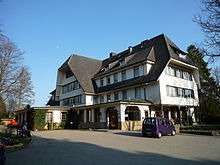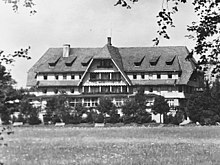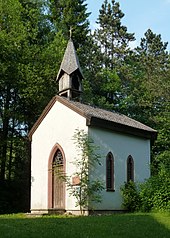Weißes Rössle (Hinterzarten)
The White Horse Inn was a hotel in Hinterzarten that was closed due to bankruptcy in the mid-1980s and has since been home to the largest employer in the municipality, the Földi Clinic for Lymphology .
history
The hotel went back to the Rössle-Wirtshaus, which was at the top of the street through the Höllental . Were on this road in both directions preload horses used: upwards because of the rise, down due to some deep ruts in the shallower parts of the departure as a result of rough blocking with brake chains , where the risk of getting stuck would have existed without preamble. At the beginning of the ascent, the inn was under the Steig (later Hofgut Sternen), at the end of the ascent the horses could either go to the Hirschen (today part of the Birklehof boarding school)) or in the Rössle inn one kilometer away. Its name - Ross with the Swabian-Alemannic diminutive ending -le - is likely to be related to the leader horses.
The only Hofgut Hinterzarten the Rösslegut is already in a 1344 Urbar mentioned. There it was given or pledged to the Günterstal Monastery by Gregor, one of the Lords of Falkenstein , as a yearly foundation. Until the middle of the 16th century, the Rösslehof belonged to the Vogtei Vorderstraß (later referred to as Breitnau and Steig), later it became part of the Vogtei Hinterstraß (today: Hinterzarten), which the geographer and librarian Ekkehard Liehl (1911-2003) thought of the division of the Sicking inheritance with the Lords of Pfirt in 1604.
From 1612 the Ober Wirtshaus , the restaurant at the Rösslehof, is documented by an addendum in the land register from 1344. However, since 1446 its owner had to pay the water interest for the use or the fishing rights ( brown trout ) on a part of the Zartenbach , with which a right to hospitality is likely to be connected.
On May 4, 1770, Marie Antoinette probably stopped here on her bridal procession to Paris . In 1773 the area of the estate was 146 Juchart and 108 Ruten , which corresponds to 50.42 hectares . From 1793 there was an imperial magazine at the Rössle , which was taken over bloodlessly by a division of Jean-Victor Moreau's army in the summer of 1796 after it had passed through the Höllental.
In the 19th century, the journey through the Höllental and with it the importance of the Rössle changed fundamentally: in 1812 the road from Freiburg via Lenzkirch to Stühlingen (the latter cities today connects the federal highway 315 ) was given the status of an extra post road . This led to the road through the Höllental being expanded from 1847 to 1857 and re-routed in places in order to reduce the gradient by means of serpentines . The aim of this measure was to abolish the pre-tensioning system so that horses no longer had to be changed on the Rössle. Thirty years later, the road traffic on the later federal highway 31 was reduced by the Höllentalbahn . In the 20th century, the triumphant advance of the car and the increasing spread of tourism meant that the Rössle could continue to exist.
In 1925, the White Horse Inn was destroyed by fire. During the reconstruction, the remaining agriculture was separated from the catering and hotel areas for the first time and the Rösslehof was built opposite the hotel. During the Second World War, the hotel was used as a partial hospital until it was so damaged by an air raid on October 15, 1944 that it had to be evacuated.
The hotel owners Otto Gremminger and his wife Hannah sold the Rössle to the Zimmermann-von der Beeck family on April 3, 1969. Under their leadership, a branch with a lever room was built across the street . In the mid-1980s, the hotel, which at that time had 120 beds, had to be closed for lack of profitability.
After the White Horse Inn was bankrupt, it was supposed to be bought up by Bhagvan supporters around Ma Anand Sheela , which led to widespread public resistance. The neighboring Birklehof boarding school turned to the Prime Minister Lothar Späth , the education professor Hellmut Becker and the boarding school board member Carl Friedrich von Weizsäcker out of concern for its students . In the end, the purchase failed because of the Sparkasse , which was not only the main creditor of the hotel, but should also have been the investor for the religious community.
Instead, the Földiklinik, a special clinic for lymphology and phlebology , moved into the hotel's premises. It was founded in 1979 by the Hungarian couple Michael and Etelka Földi in the Altglashütten district of Feldberg and was reopened on September 24, 1986 in Hinterzarten. After several renovations, it now offers 152 beds in 5 wards.
Outbuildings
In addition to the inn, there were some outbuildings owned by the Rössle:
- The already mentioned Rösslehof was built after the fire of 1925 and was leased as an economic building for about 60 years. The land to be cultivated was gradually replaced by the residential areas on the Rössleberg. In 1990/91 the large one-roof courtyard was sold and converted into apartments and business premises. The latter were initially used by Kaiser's Tengelmann , but are now home to an Edeka branch. The Landesdenkmalamt considers him, according to Liehl as worthy of preservation, but not put it under a preservation order.
- The saw of the Rösslegut was at the entrance of the Löffeltal. It was built in 1643 and was uninhabited.
- The Neuhäusle was built around 1814 as a Leibgedinge house ( Libding ) and was an extension to an existing barn. In 1892 it was sold to a Kübler, who also received a plot of 15 ares . It was located in the area of today's Freiburger Strasse, which became more important as a new residential and business area. In the 1960s, the building was replaced by a larger new building after it had previously been used as a small shop.
- The Rösslemühle on the Löffeltalbach is also no longer preserved. As evidenced for its predecessor in the same place for 1605, the miller lived in this mill with his family. They also baked there; However, when a fire destroyed the mill in 1925, more bakeries had already settled in the town center, so they were no longer rebuilt. In contrast , the community used the property as a receiving water for their first collective sewage treatment plant before it was relocated to Rappeneck. Today there are two buildings on the property, each with ten apartments.
- A similar fate befell the Upper Forge , where the blacksmith had also lived with his family. It was built in 1641 and burned down in 1866. Then it was rebuilt as a butcher's house and later acquired by a car repair shop. The building had to be demolished in 1984 when the federal highway 31 was expanded.
- The inn's court chapel has been located near the forge since the 17th century. It was replaced by a new building in 1874 by Rössle landlord Matthias Heizmann and his wife Paulina (⚭ April 23, 1857). In 1974 the chapel was demolished again and rebuilt further east, unchanged in dimensions and appearance. The letters MH and PB as well as the apostle representations of Matthias and Paul on the altar commemorate the founders of 1874 . There is a drawing of the smithy and the chapel in the Augustinermuseum in Freiburg that was created by Egidius Federle around 1830 .
Individual evidence
- ↑ Dieter Maurer: One of the leading addresses in lymphology , Badische Zeitung, July 21, 2011, accessed on November 17, 2012
- ↑ a b c Ekkehard Liehl: The road through the Höllental . In: Hinterzarten. Face and history of a Black Forest landscape . Rosgarten, Konstanz 1986, ISBN 3-87685-054-1 , p. 69 ff .
- ↑ brake chains . In: Lueger's lexicon of all technology . 2nd Edition. Volume 9, Deutsche Verlags-Anstalt, Leipzig / Stuttgart 1914, p. 102 .
- ^ Franz Josef Baer : Chronicle of road construction and road traffic in the Grand Duchy of Baden , Springer, Berlin 1878, p. 219, copy
- ^ Rüdiger Hitz: Life in the Black Forest in Baden time . In: Helmut Schubert / Gemeinde Hinterzarten (ed.): Family, work and everyday life in Hinterzarten 1600 to 1900 . Stadler, Konstanz 1998, ISBN 3-7977-0396-1 , p. 402 .
- ↑ a b c d e Hans Mahler, Berthold Ruch: The development of the Hinterzarten hotel operations . In: Ekkehard Liehl (ed.): Hinterzarten. Face and history of a Black Forest landscape . Rosgarten, Konstanz 1986, ISBN 3-87685-054-1 , p. 139 ff .
- ↑ a b c d e f g h i Ekkehard Liehl: History of the Hinterzartener Hofgüter. Stadler, Konstanz 1997, ISBN 3-7977-0394-5 , pp. 57-73.
- ^ Helmut Schubert: Hinterzarten in the 20th century. From farm to climatic health resort , Stadler, Konstanz 2002, ISBN 3-7977-0399-6 , p. 141
- ↑ The Földiklinik speaks of 96 beds on its website.
- ↑ Hanno Kühnen: Apartment Search : Rosarotes Rößle , Die Zeit , Edition 44/1985, October 25, 1985, accessed on November 18, 2012.
- ↑ : The history of the Földiklinik , official website, accessed on November 18, 2012.
Web links
- Homepage on foeldiklinik.de
Coordinates: 47 ° 54 ′ 42.4 " N , 8 ° 6 ′ 1.2" E






